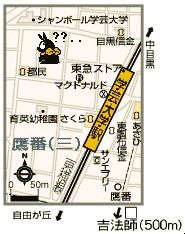But this time a good lesson on Japanese addresses is on the way! -- by Yawmin -- |
 |
 Well, P-chan has disappeared again and Akane is looking around anxiously for it. Another bad trick by Ranma? Or maybe Shampoo has kidnapped it in order to have it served as this evening's main dish at Neko Hanten restaurant? No, no Akane-san, don't worry, your P-chan is safe. It has just lost its way back home, as usual. But this time we'll try to help it with a special lesson on Japanese street addresses. Let's hope that P-chan will learn from it some more good sense of orientation and that such lesson may also help some other problematic people such as Ryoga-kun. Bye the way, strange to say, but that Ryoga-kun and P-chan share a lot of particul features, right? We all wonder the reason... Well, P-chan has disappeared again and Akane is looking around anxiously for it. Another bad trick by Ranma? Or maybe Shampoo has kidnapped it in order to have it served as this evening's main dish at Neko Hanten restaurant? No, no Akane-san, don't worry, your P-chan is safe. It has just lost its way back home, as usual. But this time we'll try to help it with a special lesson on Japanese street addresses. Let's hope that P-chan will learn from it some more good sense of orientation and that such lesson may also help some other problematic people such as Ryoga-kun. Bye the way, strange to say, but that Ryoga-kun and P-chan share a lot of particul features, right? We all wonder the reason... |
 |
Until 1946, when SCAP first decided to assign letters and numbers to major cities' streets and areas, Japanese houses didn't have any mark or number that could help to locate them. Nowadays, in cities like Tokyo or Kyoto, you may even find major roads marked by a proper name, like the central Tokyo avenues 'Meiji douri' or 'Shouwa douri' for istance. Anyway, more commonly Japanese addresses feature some of the following elements and not proper names: |
| It could be translated as prefecture. | |||
| This is a subdivision of a KEN and it could be approssimately translated as 'rural district'. | |||
| It means 'city'. Places with the status of a city are treated independently of GUN. | |||
| Commonly translated as 'ward'. A KU or ward is a section of a large city as Tokyo or Kyoto for instance. | |||
| In country districts it means 'town', but it can both refer or to a vaste zone of coltivation fields and buildings, or to one of the many different areas of a large city. MACHI is a subdivision of KU and sometimes it may only have administrative purposes. | |||
| A further division of a MACHI or CHOU. | |||
| It is a section of a CHOUME. BAN means 'number' and CHI means 'ground'. | |||
| The smallest subdivision of all. This kanji also means 'number'. Next to it sometimes there is some further data indicating the floor or flat number of the location. | |||
In postal addresses, as a general rule, these elements should be placed in the order shown above with the receiver name at the end of the address itself.

Notes:
Kanji and Kana reference:

Bibliography:
| Back to Ranma 1/2 index page | No. no P-chan, that's again the wrong way... |